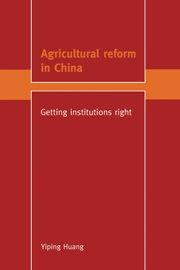Book contents
- Frontmatter
- Contents
- 1 List of figures
- 2 List of tables
- Acknowledgements
- 1 Getting markets to work in the countryside
- 2 Institutional distortions in pre-reform agriculture
- 3 Getting farmers back to work
- 4 Getting prices right
- 5 Adjustments in rural markets bring structural change
- 6 An agricultural economy without freedom to trade
- 7 China's agricultural policy choices
- 8 Chinese farmers can adapt
- 9 Getting reform right in agriculture
- Appendix: The China model
- References
- Index
3 - Getting farmers back to work
Published online by Cambridge University Press: 18 June 2010
- Frontmatter
- Contents
- 1 List of figures
- 2 List of tables
- Acknowledgements
- 1 Getting markets to work in the countryside
- 2 Institutional distortions in pre-reform agriculture
- 3 Getting farmers back to work
- 4 Getting prices right
- 5 Adjustments in rural markets bring structural change
- 6 An agricultural economy without freedom to trade
- 7 China's agricultural policy choices
- 8 Chinese farmers can adapt
- 9 Getting reform right in agriculture
- Appendix: The China model
- References
- Index
Summary
Early institutional experiments
Returning the responsibility for production decisions to farmers is now regarded as one of the most successful moves made during China's whole reform experience. The government did not intentionally set out to do this at the beginning of the reforms. But by 1978 the government had recognised that solving managerial problems within the production team system in agriculture was the key to improving productivity by raising farmers’ incentives. In fact the subdivision of collectively owned land and delegation of production management to individual households were both considered violations of socialist principles and were formerly unthinkable (Lin 1994). The introduction of the household responsibility system and other forms of household-based systems began spontaneously with farmers taking production decisions into their own hands in remote areas within the pre-reform agricultural regime. The speed with which the household responsibility system became widespread at the beginning of the 1980s is astonishing. Individual systemic changes became a revolution that was built on several decades’ experiments and learning by Chinese farmers.
The first experiments with the contract system in agriculture began as early as collectivisation – roughly the same time as the massive introduction of elementary co-operatives. In 1956, various forms of production responsibility systems, including management responsibility systems and contracting of output and cost, were created and operated experimentally within Yongjia county and Ruian county of Zhejiang province, Fengyang county of Anhui province, Yuci county of Shanxi province and Jiangjing county of Sichuan province. ‘Contracting everything to the household’ (Baogan Daohu) was widespread in Henan province in 1959 and in the southwest and northwest areas in 1964.
- Type
- Chapter
- Information
- Agricultural Reform in ChinaGetting Institutions Right, pp. 38 - 53Publisher: Cambridge University PressPrint publication year: 1998

